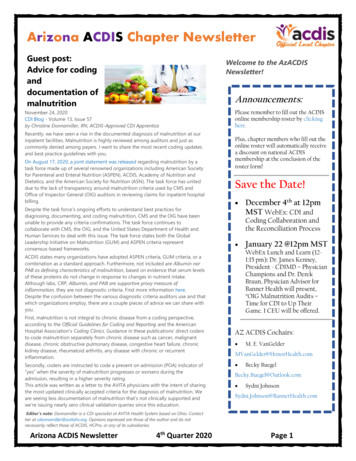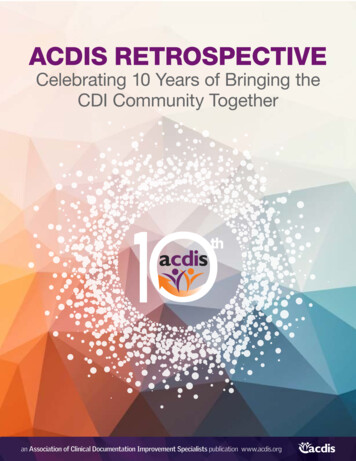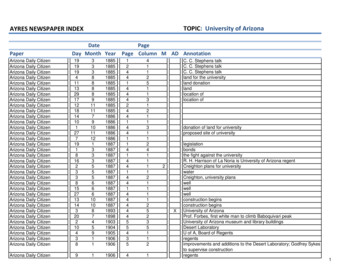
Transcription
Arizona ACDIS Chapter NewsletterGuest post:Advice for codinganddocumentation ofmalnutritionWelcome to the AzACDISNewsletter!Announcements:November 24, 2020CDI Blog - Volume 13, Issue 57by Christine Donnamiller, RN, ACDIS-Approved CDI ApprenticeRecently, we have seen a rise in the documented diagnosis of malnutrition at ourinpatient facilities. Malnutrition is highly reviewed among auditors and just ascommonly denied among payers. I want to share the most recent coding updatesand best practice guidelines with you.On August 17, 2020, a joint statement was released regarding malnutrition by atask force made up of several renowned organizations including American Societyfor Parenteral and Enteral Nutrition (ASPEN), ACDIS, Academy of Nutrition andDietetics, and the American Society for Nutrition (ASN). The task force has uniteddue to the lack of transparency around malnutrition criteria used by CMS andOffice of Inspector General (OIG) auditors in reviewing claims for inpatient hospitalbilling.Despite the task force’s ongoing efforts to understand best practices fordiagnosing, documenting, and coding malnutrition, CMS and the OIG have beenunable to provide any criteria confirmations. The task force continues tocollaborate with CMS, the OIG, and the United States Department of Health andHuman Services to deal with this issue. The task force states both the GlobalLeadership Initiative on Malnutrition (GLIM) and ASPEN criteria representconsensus-based frameworks.Please remember to fill out the ACDISonline membership roster by clickinghere.Plus, chapter members who fill out theonline roster will automatically receivea discount on national ACDISmembership at the conclusion of theroster form!Save the Date! Coding Collaboration andthe Reconciliation Process Secondly, coders are instructed to code a present on admission (POA) indicator of“yes” when the severity of malnutrition progresses or worsens during theadmission, resulting in a higher severity rating.This article was written as a letter to the AVITA physicians with the intent of sharingthe most updated clinically accepted criteria for the diagnosis of malnutrition. Weare seeing less documentation of malnutrition that’s not clinically supported andwe’re issuing nearly zero clinical validation queries since this education.January 22 @12pm MSTWebEx Lunch and Learn (121:15 pm): Dr. James Kenney,President - CDIMD – PhysicianChampions and Dr. DerekBraun, Physician Advisor forBanner Health will present,“OIG Malnutrition Audits –Time for CDI to Up TheirGame. 1 CEU will be offered.ACDIS states many organizations have adopted ASPEN criteria, GLIM criteria, or acombination as a standard approach. Furthermore, not included are Albumin norPAB as defining characteristics of malnutrition, based on evidence that serum levelsof these proteins do not change in response to changes in nutrient intake.Although labs, CRP, Albumin, and PAB are supportive proxy measure ofinflammation, they are not diagnostic criteria. Find more information here.Despite the confusion between the various diagnostic criteria auditors use and thatwhich organizations employ, there are a couple pieces of advice we can share withyou.First, malnutrition is not integral to chronic disease from a coding perspective,according to the Official Guidelines for Coding and Reporting and the AmericanHospital Association’s Coding Clinics. Guidance in these publications’ direct codersto code malnutrition separately from chronic disease such as cancer, malignantdisease, chronic obstructive pulmonary disease, congestive heart failure, chronickidney disease, rheumatoid arthritis, any disease with chronic or recurrentinflammation.December 4th at 12pmMST WebEx: CDI andAZ ACDIS Cochairs: M. E. VanGelderMVanGelder@HonorHealth.com Becky BuegelBecky.Buegel@Outlook.com Sydni JohnsonSydni.Johnson@BannerHealth.comEditor’s note: Donnamiller is a CDI specialist at AVITA Health System based on Ohio. Contacther at cdonnamiller@avitahs.org. Opinions expressed are those of the author and do notnecessarily reflect those of ACDIS, HCPro, or any of its subsidiaries.Arizona ACDIS Newsletter4th Quarter 2020Page 1
Arizona ACDIS Chapter NewsletterGuest post: Coding an out-of-hospitalcardiac arrestOctober 27, 2020CDI Blog - Volume 13, Issue 54by artHowardRodenberg,MPH,CCDSTheof medicine,(and,MD,for thatmatter,the art of life) is most often taught through what we call “pearls of wisdom.”These are those succinct nuggets of information learned through life experiences, tidbits of knowledge not found inbooks.In healthcare, some pearls are metaphorical. For example, the adage “When you hear hoofbeats, look for horses, notzebras,” is a reminder that common things happen commonly, and not everyone has a publication-worthy illness.Others are more concrete. “If someone usually walks, talks, eats, drinks, looks, and smells normal, and now theydon’t, you can’t send them home” is good advice in determining the need for admission.Another group of pearls are more definitive. A preceptor during my Emergency Medicine residency quipped, “You’reeither alive or dead. There’s nothing in between.” (This was an attending physician without any ex-wives, which doescast some doubt on his opinion.)This latter reflection came back to me recently as I received a note from Diana Matysik, a CDI supervisor forAscension Health in Duluth, Minnesota, who asked a question near and dear to my emergency department (ED)heart. If a patient suffers an out-of-hospital cardiac arrest and is resuscitated before arrival in the ED, should thescenario be described with a Z code?(Duluth is pretty far north, sitting on the shores of Lake Superior. I understand that summer is scheduled for the thirdweek of August, followed by winter, more winter, and worst winter. That takes us through September. And as you mayknow, Duluth also is the hometown of one Robert Zimmerman, also known as Bob Dylan. Early in his career, heshared the stage with Bobby Vee, best known for a tune called “The Night has a Thousand Eyes,” to which theBeloved Dental Empress refers me when discussing the Rules of the Relationship, along with the Beatle’s “Happinessis a Warm Gun.” I think there a message there.)The place to start the discussion is to look at how we should code cardiac arrest. The best summary we have is anote in Coding Clinic, second quarter 1988, which described four scenarios in which one might code cardiac arrest: If the patient arrives in the hospital’s emergency service unit in a state of cardiac arrest, cannot be resuscitatedor only briefly resuscitated, and is pronounced dead with the underlying cause of the cardiac arrest notestablished (cause unknown), code 427.5 is assigned as the diagnosis.If the patient arrives at the hospital in a state of cardiac arrest, is resuscitated, and is admitted as an inpatientbut dies before the underlying cause of the cardiac arrest is established (cause unknown), code 427.5 isassigned as the principal diagnosis.Code 427.5, Cardiac arrest, may be used as a secondary code in the following instances:ooThe patient arrives in the hospital’s emergency service unit in a state of cardiac arrest and isresuscitated (and admitted) with the condition prompting the cardiac arrest known, such as ventriculartachycardia or trauma. The condition causing the cardiac arrest is sequenced first followed by code427.5, Cardiac arrest.When cardiac arrest occurs during the course of hospitalization and the patient is resuscitated, code427.5 may be used as a secondary code except as outlined in the exclusion note under category 427.When the physician records cardiac arrest to indicate an inpatient death, do not assign code 427.5 when theunderlying cause or contributing cause of death is known since the Uniform Hospital Discharge Data Set (UHDDS)has a separate item for reporting deaths occurring during an inpatient stay.Arizona ACDIS Newsletter4th Quarter 2020Page 2
Arizona ACDIS Chapter NewsletterGuest post: Coding an out-of-hospital cardiac arrest (continued)(Note that this Coding Clinic is from the ICD-9-CM era. Today, we would translate these scenarios into ICD-10-CM codesI46.2, I46.8, or I46.9 accordingly if the cause of the arrest is known or unknown.)The scenario Coding Clinic seems to leave out is when a patient comes in with cardiac arrest, is resuscitated, doesn’t die,and you never find out the cause. In that case, I think code I46.9, Cardiac arrest, cause unspecified, would be an appropriateprincipal diagnosis.(Side note: Erica Remer, MD, FACEP, CCDS, president and founder of Erica Remer, MD, Inc., penned a nice review of theuse of cardiac arrest codes in the acute setting for ICD-10 Monitor. Highly recommend.)The situation described by my colleague from the frozen tundra is different. In this event, a patient found in prehospitalcardiac arrest is fully resuscitated prior to arrival in the hospital, to the extent that active resuscitation is not in process whilecrossing the hospital doors. Could you use a Z code, specifically Z86.74, Personal history of sudden cardiac arrest, torepresent the out of hospital arrest in someone who’s already resuscitated?I think you can, but with a specific caution. Just like there’s a plain reading to the terms “alive” and “dead,” I think there’s aplain reading to the phrase “personal history of ” within the Z codes. “Personal history of ” means these conditions are inthe past, and more specifically, not directly impactful to the current admission.This is one of those times that Coding World and Clinical World collide. There is no question that a history of a particularcondition may be relevant for the treating provider. If I know a patient has a history of breast cancer, and she presents with achronic cough, you bet I’m getting the chest x-ray to be worried about a possible recurrence with pulmonary metastases. Butfrom a coding standpoint, if the same patient gets admitted for pneumonia, does that personal history really matter? Probablynot. It’s over and done with in respect to its impact on the current hospital stay.So, the caution about using the Z code for “personal history of sudden cardiac arrest” would be the proximity of the arrest tothe admission. If the patient is freshly resuscitated and brought to the hospital, I don’t think the Z code would be appropriate,as the evaluation and care of the prehospital arrest is still in process. However, during subsequent admissions (or officevisits, for that matter), the Z code would be entirely appropriate for use, as the acute episode of cardiac arrest precipitatingthe index admission to the hospital is resolved.(As an aside, does it strike anyone else as ironic that if a patient has a cardiac arrest in the hospital and dies, it’s notrecorded as an MCC? Intuitively, you would think that death would be the ultimate MCC. But it’s probably true that the needfor additional monitoring, evaluation, treatment, nursing care, or further length of stay end at that point, at least in the earthlyrealm. I suppose the actuaries win on this one. Just another pearl for you.)Editor’s note: Rodenberg is the adult physician advisor for CDI at Baptist Health in Jacksonville, Florida. Contact himat howard.rodenberg@bmcjax.com or follow his personal blog at writingwithscissors.blogspot.com. Advice given is general. Readers shouldconsult professional counsel for specific legal, ethical, clinical, or coding questions. Opinions expressed are that of the author and do notrepresent HCPro or ACDIS.Upcoming ACDIS Events, Education, and CEUs: ACDIS update: Listen to the latest Quarterly CallNovember 19, 2020, CDI Strategies - Volume 14, Issue 52Arizona ACDIS Newsletter4th Quarter 2020Page 3
Arizona ACDIS Chapter NewsletteroThe latest ACDIS Quarterly Membership Conference Call took place on Thursday, November 19, 1-2 p.m.EST. This call features a special replay of The Art of Communication and the Value of CDI, originallybroadcast during the September Curtain Call virtual event.oClick here to access the November ACDIS Quarterly Membership Conference Call, then fill out the surveyfor 1 CEU credit.Join ACDIS Director Brian Murphy every other Wednesday for the ACDIS Podcast: Talking CDI, a biweekly live podcast covering the hottest topics in CDI.During each ACDIS Podcast episode, Brian Murphy and a co-host chat with a special guestincluding industry leaders, ACDIS advisory board members, physicians and physician advisors,and CDI managers and specialists. You'll hear about best practices, tips, and the latest ACDIS andCDI-related healthcare news. This lively 30-minute program will keep CDI and HIM professionalsentertained and up-to-date on the pulse of the CDI industry.Tune in every other Wednesday at 11:30 a.m. eastern.Please note that the GoToWebinar platform sometimes displays the times in GMT in reminderemails leading up to the live program.Can't listen live? Subscribe on Apple Podcasts, Google Play, or Spotify and listen on the go. The ondemand podcast goes live the Friday following the live show date. ACDIS Online: Uncovering Outpatient CDI OpportunitiesDecember 9–11, 2020Click here for more informationReserve your calendar for Dec. 9-11! This three-day, one-of-a-kind online event offers CDI professionals a unique chance tointerrogate the benefits of medical record reviews in this non-traditional healthcare setting. Join those who’ve pioneered outpatientCDI endeavors and learn from their challenges and successes. Collaborate with colleagues in the outpatient arena to identify bestpractices and investigate common clinical scenarios. Follow the evidence and gather tools from nearly a dozen respected industryleaders and experts in the field.Event facts:-Three, half-day, schedule allows attendees to participate and network in real time or listen as their schedule allows-Unique, small-group networking opportunities, plus interactive thought exchanges within our event app2021 Annual Conference IMPORTANT NOTICE: With the uncertainty remainingaround the COVID-19 pandemic, ACDIS has made the decision to reschedule ourannual conference to October 25-28, 2021, at the Sheraton Hotel in Dallas, Texas.Due to this move, we will keep the conference speaker application period openthrough January 8, 2021. We encourage you to apply to speak by clicking here.-To learn more about the ACDIS conference, take a look at our video and seethe excitement for yourself.-If you have any questions, email Associate Editorial Director MelissaVarnavas (mvarnavas@acdis.org). We hope you’ll consider sharing yourexperiences and expertise.Arizona ACDIS Newsletter4th Quarter 2020Page 4
Arizona ACDIS Chapter Newsletter Real-Time Clinical Intelligence at the Point of Care: Seamless HierarchicalCondition Category (HCC) ManagementNovember 17, 2020Free ResourcesCDI Expansion, CDI ManagementLeverage technology to capture HCCs across the continuumManaging patient risk has never been more crucial. Accurate capture of Hierarchical Condition Categories (HCCs) is essential toaccurate risk scores. Both clinicians and CDI teams need real-time clinical intelligence to identify HCC opportunities and closedocumentation gaps before claims are submitted.An integrated HCC management solution requires built-in worklist prioritization to identify diagnosis gaps and missingdocumentation, year after year, especially in outpatient settings. CDI teams also need to adapt to ongoing changes, such as newregulation during the COVID-19 pandemic to allow submission of diagnoses via telehealth. Leveraging AI technology helpsprovide real-time access to a patient’s entire clinical history and identifies HCC opportunities that would otherwise be missed.Download the free e-GuideDownload Adapting CDI to Deliver Impactful Outcomes for the Current & FutureHealthcare EnvironmentOctober 29, 2020Free ResourcesCDI Expansion, CDI ManagementThe rapidly evolving landscape of healthcare has often led to CDI being pulled in multiple directions for various initiatives. Since theimpact of accurate and compliant clinical documentation is more expansive today than it was ten years ago, we have to maintain aneffective balance between several hospital initiatives which ranges from Finance to Quality. It becomes clear then, that our originalapproach will only get us so far. Advancing to a more streamlined and focused approach allows for expansive program growth,while maintaining adherence to the mission of CDI.Join Deanne Wilk, CDI Manager for Penn State Health and Dr. Terrance Govender, VPMA for ClinIntell on Thursday,October 29th at 1 pm ET, as they discuss Penn State Health’s true north and vision for CDI that breaks the mold of traditionalapproaches and methodologies to deliver wide-ranging value and true sustainable impact.Learning Objectives: Understand the specific challenges that traditional approaches and metrics pose to CDI delivering broad-based value Learn what components of a revised approach will increase your chances of success Expand your knowledge on CDI advancement and growth opportunitiesRegisterWe would like to hear from you! We are requesting suggestions for information to be included in our AzACDISNewsletter. We are also looking for volunteers to write an article to be featured in an upcoming newsletter. Pleaseemail Sydni Johnson at Sydni.Johnson@BannerHealth.com with ideas or if you are interested in contributing to thenewsletter.Arizona ACDIS Newsletter4th Quarter 2020Page 5
for Parenteral and Enteral Nutrition (ASPEN), ACDIS, Academy of Nutrition and Dietetics, and the American Society for Nutrition (ASN). The task force has united due to the lack of transparency around malnutrition criteria used by CMS and . Arizona ACDIS Newsletter 4th Quarter 2020 Page 2 Arizona ACDIS Chapter Newsletter Guest post: Coding an .










